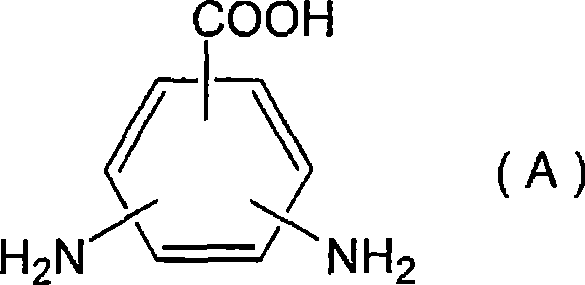Liquid crystal oriented agent and liquid crystal display element
A technology of liquid crystal alignment agent and substance, which is applied in liquid crystal materials, chemical instruments and methods, optics, etc., and can solve problems such as thermal deterioration of liquid crystal alignment film, unknown, and drop in liquid crystal voltage retention rate
- Summary
- Abstract
- Description
- Claims
- Application Information
AI Technical Summary
Problems solved by technology
Method used
Image
Examples
Synthetic example 1
[0127] Synthesis Example 1 (Synthesis Example 1 of Polyimide)
[0128] 112g (0.50 moles) of 2,3,5-tricarboxycyclopentylacetic dianhydride as tetracarboxylic dianhydride and 1,3,3a,4,5,9b-hexahydro-8-methyl-5- (Tetrahydro-2,5-dioxo-3-furyl)-naphthalene[1,2-c]-furan-1,3-dione 157g (0.50 moles), p-phenylenediamine as diamine 83g (0.78 mol), 3,5-diaminobenzoic acid 15.2g (0.10 mol), diaminopropyl tetramethyldisiloxane 25g (0.10 mol) and 3,6-bis(4-aminobenzoyloxy 13 g (0.020 moles) of cholestane, and 2.7 g (0.030 moles) of aniline as a monoamine were dissolved in 960 g of N-methyl-2-pyrrolidone, and reacted at 60 ° C for 6 hours to obtain polyamic acid solution. A small amount of the obtained polyamic acid solution was taken, and N-methyl-2-pyrrolidone was added to prepare a solution with a concentration of 10% by weight. The measured solution viscosity was 48 mPa·s.
[0129] Then, 2700 g of N-methyl-2-pyrrolidone was added to the obtained polyamic acid solution, and 396 g of py...
Synthetic example 2
[0131] Synthesis example 2 (synthesis example 2 of polyimide)
[0132] 224g (1.0 mol) of 2,3,5-tricarboxycyclopentyl acetic dianhydride as tetracarboxylic dianhydride, 76g (0.7 mol) of p-phenylenediamine as diamine, 3,5-diaminobenzoic acid 15g (0.10 mol) and 105g (0.20 mol) of the compound represented by the above-mentioned formula (D-10) were dissolved in 4500g of N-methyl-2-pyrrolidone and reacted at 60°C for 6 hours to obtain polyamic acid-containing solution. A small amount of the obtained polyamic acid solution was taken, concentrated under reduced pressure to prepare a solution with a concentration of 10% by weight, and the measured solution viscosity was 60 mPa·s.
[0133] Then, 2700 g of N-methyl-2-pyrrolidone was added to the obtained polyamic acid solution, and 396 g of pyridine and 409 g of acetic anhydride were added, and a dehydration ring-closing reaction was performed at 110° C. for 4 hours. After the dehydration ring-closing reaction, by the solvent in the sy...
Synthetic example 3
[0135] Synthesis example 3 (synthesis example 3 of polyimide)
[0136] 77g (0.34 mol) of 2,3,5-tricarboxycyclopentyl acetic dianhydride as tetracarboxylic dianhydride, 19g (0.18 mol) of p-phenylenediamine as diamine, 3,5-diaminobenzoic acid 27 g (0.18 mol) was dissolved in 1260 g of N-methyl-2-pyrrolidone and allowed to react at room temperature for 6 hours to obtain a solution containing polyamic acid. A small amount of the obtained polyamic acid solution was taken, concentrated under reduced pressure to prepare a solution with a concentration of 10% by weight, and the measured solution viscosity was 80 mPa·s.
[0137] Then, 600 g of N-methyl-2-pyrrolidone was added to the obtained polyamic acid solution, 136 g of pyridine and 105 g of acetic anhydride were added, and a dehydration ring-closure reaction was performed at 110° C. for 4 hours. After the dehydration ring-closing reaction, by the solvent in the system is carried out solvent replacement with new γ-butyrolactone, t...
PUM
| Property | Measurement | Unit |
|---|---|---|
| thickness | aaaaa | aaaaa |
| viscosity | aaaaa | aaaaa |
| viscosity | aaaaa | aaaaa |
Abstract
Description
Claims
Application Information
 Login to View More
Login to View More - R&D
- Intellectual Property
- Life Sciences
- Materials
- Tech Scout
- Unparalleled Data Quality
- Higher Quality Content
- 60% Fewer Hallucinations
Browse by: Latest US Patents, China's latest patents, Technical Efficacy Thesaurus, Application Domain, Technology Topic, Popular Technical Reports.
© 2025 PatSnap. All rights reserved.Legal|Privacy policy|Modern Slavery Act Transparency Statement|Sitemap|About US| Contact US: help@patsnap.com



